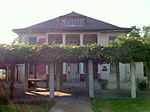La Puente Valley Woman's Club
American Craftsman architecture in CaliforniaBuildings and structures completed in 1923Buildings and structures on the National Register of Historic Places in Los Angeles County, CaliforniaBungalow architecture in CaliforniaClubhouses on the National Register of Historic Places in Los Angeles ... and 6 more
Clubs and societies in CaliforniaHistory of women in CaliforniaLa Puente, CaliforniaLos Angeles County, California Registered Historic Place stubsWomen's club buildings in CaliforniaWomen's clubs in the United States

La Puente Valley Women's Club is a women's club building located in the La Puente Downtown Business District of La Puente, in eastern Los Angeles County, California.
Excerpt from the Wikipedia article La Puente Valley Woman's Club (License: CC BY-SA 3.0, Authors, Images).La Puente Valley Woman's Club
North 2nd Street,
Geographical coordinates (GPS) Address Nearby Places Show on map
Geographical coordinates (GPS)
| Latitude | Longitude |
|---|---|
| N 34.021944444444 ° | E -117.95138888889 ° |
Address
North 2nd Street
North 2nd Street
91744
California, United States
Open on Google Maps






